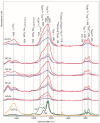Calcification of Various Bioprosthetic Materials in Rats: Is It Really Different?
- PMID: 37108443
- PMCID: PMC10139218
- DOI: 10.3390/ijms24087274
Calcification of Various Bioprosthetic Materials in Rats: Is It Really Different?
Abstract
The causes of heart valve bioprosthetic calcification are still not clear. In this paper, we compared the calcification in the porcine aorta (Ao) and the bovine jugular vein (Ve) walls, as well as the bovine pericardium (Pe). Biomaterials were crosslinked with glutaraldehyde (GA) and diepoxide (DE), after which they were implanted subcutaneously in young rats for 10, 20, and 30 days. Collagen, elastin, and fibrillin were visualized in non-implanted samples. Atomic absorption spectroscopy, histological methods, scanning electron microscopy, and Fourier-transform infrared spectroscopy were used to study the dynamics of calcification. By the 30th day, calcium accumulated most intensively in the collagen fibers of the GA-Pe. In elastin-rich materials, calcium deposits were associated with elastin fibers and localized differences in the walls of Ao and Ve. The DE-Pe did not calcify at all for 30 days. Alkaline phosphatase does not affect calcification since it was not found in the implant tissue. Fibrillin surrounds elastin fibers in the Ao and Ve, but its involvement in calcification is questionable. In the subcutaneous space of young rats, which are used to model the implants' calcification, the content of phosphorus was five times higher than in aging animals. We hypothesize that the centers of calcium phosphate nucleation are the positively charged nitrogen of the pyridinium rings, which is the main one in fresh elastin and appears in collagen as a result of GA preservation. Nucleation can be significantly accelerated at high concentrations of phosphorus in biological fluids. The hypothesis needs further experimental confirmation.
Keywords: bioprosthetic materials; calcification; collagen; cross-linking; elastin.
Conflict of interest statement
The authors declare no conflict of interest.
Figures









Similar articles
-
In search of the best xenogeneic material for a paediatric conduit: an experimental study.Interact Cardiovasc Thorac Surg. 2018 May 1;26(5):738-744. doi: 10.1093/icvts/ivx445. Interact Cardiovasc Thorac Surg. 2018. PMID: 29346675
-
Influence of species, environmental factors, and tissue cellularity on calcification of porcine aortic wall tissue.Semin Thorac Cardiovasc Surg. 2001 Oct;13(4 Suppl 1):99-105. Semin Thorac Cardiovasc Surg. 2001. PMID: 11805957
-
Curcumin-crosslinked acellular bovine pericardium for the application of calcification inhibition heart valves.Biomed Mater. 2020 May 5;15(4):045002. doi: 10.1088/1748-605X/ab6f46. Biomed Mater. 2020. PMID: 31972553
-
Calcification of tissue heart valve substitutes: progress toward understanding and prevention.Ann Thorac Surg. 2005 Mar;79(3):1072-80. doi: 10.1016/j.athoracsur.2004.06.033. Ann Thorac Surg. 2005. PMID: 15734452 Review.
-
Initiation of Medial Calcification: Revisiting Calcium Ion Binding to Elastin.J Phys Chem B. 2024 Oct 10;128(40):9631-9642. doi: 10.1021/acs.jpcb.4c04464. Epub 2024 Sep 26. J Phys Chem B. 2024. PMID: 39324564 Review.
Cited by
-
Biopolymer/Suture Polymer Interaction: Is It a Key of Bioprosthetic Calcification?Polymers (Basel). 2025 Jun 5;17(11):1576. doi: 10.3390/polym17111576. Polymers (Basel). 2025. PMID: 40508818 Free PMC article.
-
In Vitro Study of Composite Cements on Mesenchymal Stem Cells of Palatal Origin.Int J Mol Sci. 2023 Jun 30;24(13):10911. doi: 10.3390/ijms241310911. Int J Mol Sci. 2023. PMID: 37446086 Free PMC article.
-
The Potential of Composite Cements for Wound Healing in Rats.Bioengineering (Basel). 2024 Aug 16;11(8):837. doi: 10.3390/bioengineering11080837. Bioengineering (Basel). 2024. PMID: 39199795 Free PMC article.
-
A Novel Polymer Film to Develop Heart Valve Prostheses.Polymers (Basel). 2024 Nov 29;16(23):3373. doi: 10.3390/polym16233373. Polymers (Basel). 2024. PMID: 39684117 Free PMC article.
References
-
- Schoen F.J., Levy R.J. Bioprosthetic Heart Valve Calcification: Clinicopathologic Correlations, Mechanisms, and Prevention. In: Aikawa E., Hutcheson J.D., editors. Cardiovascular Calcification and Bone, Mineralization. 1st ed. Humana Press; Totowa, NJ, USA: Springer Nature Switzerland AG; Cham, Switzerland: 2020. pp. 183–218. - DOI
-
- Duijvelshoff R., Di Luca A., Van Haaften E.E., Dekker S., Söntjens S.H.M., Janssen H.M., Smits A.I.P.M., Dankers P.Y.W., Bouten C.V.C. Inconsistency in Graft Outcome of Bilayered Bioresorbable Supramolecular Arterial Scaffolds in Rats. Tissue Eng. 2021;27:894–904. doi: 10.1089/ten.tea.2020.0185. - DOI - PubMed
MeSH terms
Substances
Grants and funding
LinkOut - more resources
Full Text Sources
Medical

